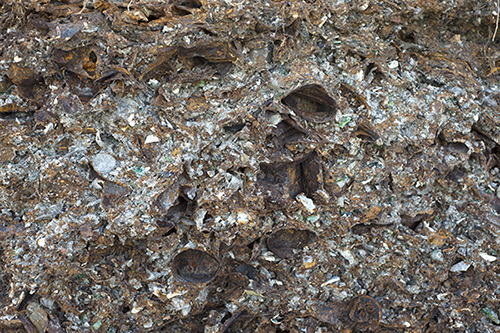
May 9 - June 30, 2017

For each exhibition, the Blackwood Gallery presents an artwork in the Bernie Miller Lightbox, a billboard-sized (108" x 72") venue installed on the outside of the William Davis Building where the two wings of the building meet at the end of the "Five Minute Walk".
Leslie Street Spit Geologies is part of the exhibition Ground/works, curated by curators7, on view from May 8–12, 2017.
Lisa Hirmer’s series of photographs, Leslie Street Spit Geologies (2012), is a visual documentation of the accumulation of clean fill, demolition waste, and other detritus that forms the seemingly “natural” environment of the human-constructed spit that abuts Toronto’s shoreline. Hirmer’s photographs are typically presented in a gallery setting and emphasize the banal in contemporary Canadian landscapes—a subject that has historically been mythologized and monumentalized in museums displays, visual culture and throughout the history of Canadian painting. Displayed here as a lightbox print, this particular image suggests a different reading of the land. Viewed against the concrete, brutalist exterior of the William G. Davis Building, the mix of plastic, concrete, glass, and organic debris that covers the Leslie Spit makes visible the contrast in materiality between soil and concrete, and between infrastructure and nature. The relationship between natural and human-made or artificial environments is a theme Hirmer observes throughout her art practice.
Lisa Hirmer is an inter-disciplinary artist based in Guelph, Canada, working at the intersections of visual art, social practice, performance, and art-based forms of critical research. Her experimental public-focused practice, DodoLab, explores and responds to the complicated and nebulous reality of public opinion (acknowledging that this is itself a complicated idea). Her work as a photographer and writer explores contemporary landscapes and built environments. Operating both within gallery and non-traditional settings, she has created projects across Canada and internationally, at art galleries, including Harbourfront Centre (Toronto), University of Lethbridge Gallery, Peninsula Arts (U.K.), Flux Factory (USA), Kitchener-Waterloo Art Gallery and Doris McCarthy Gallery (Toronto); for art events including Nuit Blanche Toronto and CAFKA (Kitchener-Waterloo); with service organizations, such as the Ontario Trillium Foundation (Sudbury); for municipalities, including Breckland Council (U.K.) and the City of Guelph; and academic groups, including the International Institute for Critical Studies in Improvisation (University of Guelph). Recent residencies include the Centre for Contemporary Art & the Natural World (U.K.), Time_Place_Space by Arts House (Australia), the Santa Fe Art Institute, and the Robert Rauschenberg Foundation (USA). She is a graduate of the University of Waterloo.
This exhibition is produced in partial fulfilment of FAH451: Curatorial Practice, a capstone course in the new Curatorial Studies Certificate Program in the Department of Visual Studies at the University of Toronto Mississauga.
curators7 would like to express thanks to the Department of Visual Studies and the Blackwood Gallery staff for their continued support, guidance, and encouragement, without which this project would not have been possible, to the DVS Student Society for their engagement with students across campus, and to UTM Facilities Management & Planning and Chartwells Catering.
curators7 is particularly thankful for the loan of Young & Giroux’s Infrastructure Canada, which is borrowed from the collection of Oakville Galleries.
